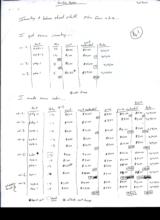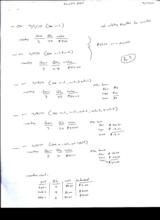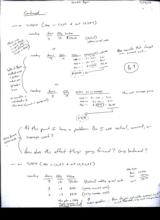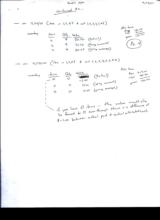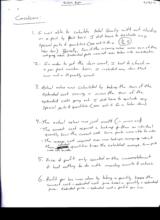|
Basic Assignments
|
Options & Settings
|
Main Time Information
|
||||||||||||||||||||||
|
|
|
|
|
||||||
|
||||||
|
|
|
Notes:
|
|
Inventory & balance sheet stuff. Flow from a to z… (See charts on scan in photo gallery – 5 pages dated 2/13/10) Sections: “I received some inventory…”: - Part - Qty - Cost - Cost - Extended - Date “I made some sales…”: - Part - Qty - Cost - Cost extended Profit: - Price - Price extended - Date Scratch paper continuing counts and flow: (See scans in photo gallery for 5 pages dated 2/13/10) Notes from working through these examples: - There was a cost change on part pdq-1 and we still had a couple in stock - Both of these (referring to 2 different methods on sheet) methods cause a problem when you go back in time (the variable that changed was current cost…) - A variable is introduced in to the mix (current or average cost) – this uses average price - Some known issues arise: o At this point I have a problem. Do I use actual, current, or average cost? o How does this effect things going forward? Going backward? - This gets a little cloudy because it gets hard to tell what is real o New question: How do you calculate average cost? In, out, both, extended, only cost changes, how? - If you have 0 items… the value would also be forced to 0 even though there is a difference of $ -1.00 between actual paid and actual attributed cost. Conclusions: 1. I was able to calculate total Quantity without checking on a part by part basis. I did have to exclude any special parts and quantities (see out_5 for a labor item). Basically, sum of the incoming values minus sum of the outgoing values. Individual parts were not eve taken into consideration. 2. In order to get the item count, I had to check on a per part number basis. I included any item that was not a 0 quantity count. 3. Actual value was calculated by taking the sum of the extended cost coming in minus the sum of the extended costs going out. I did have to exclude any special parts and quantities (see out_5 for a labor item). 4. The actual values were just math (in minus out). a. The current cost required a look-up and then an individual quantity times the current cost. Some parts were able to ride. b. The average cost required even more look-ups, averaging calcs, and then individual quantities multiplied by the calculated average. Some parts were able to ride. 5. Price and profit only counted on the income statement and had nothing to do with inventory counts and values. 6. Profit per line was done by taking a quantity times the current cost = extended cost price times a quantity = extended price. Extended price – extended cost = profit per line. |

